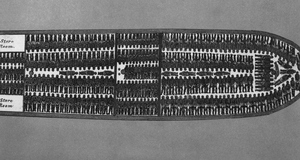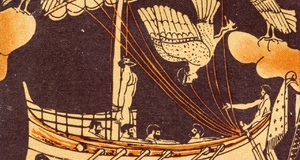Redemption and Reconciliation in Oedipus at Colonus and Gran Torino: A Comparative Reading
By
2020, Vol. 12 No. 10 | pg. 1/1 AbstractThis paper presents a comparative analysis of Oedipus at Colonus, a play written by the ancient Greek tragedian Sophocles, and Gran Torino, an American film directed by Clint Eastwood. The two literary productions, although remote as they seem, contain significant parallels and similarities that reveal trans-temporal themes of human life. The paper first analyzes the shared arc of narrative: both stories depict the journey of alienated, polluted sinners moving away from isolation and sin; by attaining humbleness, re-establishing social relationships, and atoning externally for their past sins, the sinners eventually become re-integrated into communities and acquire a spiritual sensibility. The paper’s analysis of the religious-spiritual dimension in the two narratives shows how tragedies can be transformed into stories of reconciliation. Finally, the paper concludes with the idea that the two stories express an optimistic view toward life and death: a polluted sinner can gain peace through positive social relationships and can be saved by external atonement; moreover, sinners can become saviors. Oedipus at Colonus is one of the three Theban plays written by the ancient Greek tragedian Sophocles. Postdating Oedipus the King, it begins years after Oedipus’ exile and ends with his death. The play preserves traditional tragic elements but achieves a breakthrough in its religious contemplation. Its narrative culminates not in bitter tragedy, as does Oedipus the King, but in a gesture toward redemption. Gran Torino, a 2008 American drama film directed by Clint Eastwood, parallels the Sophoclean arc. Depicting the journey of Walt, a Korean War veteran and a retired autoworker, the film begins with Walt’s alienation from society and ends with his funeral, a seemingly tragic chronicle. However, by integrating religious themes, Gran Torino takes the audience beyond tragedy. The parallel between the two literary productions suggests a comparative analysis, a perspective that might reveal trans-temporal themes and universal wisdom, independently of any question of influence. The stories of Oedipus and Walt differ -- for example, Walt commits a sin freely and lives in guilt, whereas Oedipus suffers from involuntary actions and insists on his innocence -- yet it is surprising how many similarities exist. Both works portray the journeys of alienated, polluted sinners who achieve re-integration, redemption, and become saviors. The religious-spiritual dimension allows the narratives to move beyond bitter tragedy; they become stories of reconciliation that incorporate optimistic visions of death and life. Oedipus and Walt both experience alienation from society that manifests itself in physical detachment and identity crisis. Exiled from Thebes, Oedipus appears in the story frail and isolated, accompanied only by his daughter Antigone. The exile contains a twofold meaning: he is not only physically banished, but also deprived of self-identity. Once a king of Thebes, a husband to a wife, a resident to a homeland, Oedipus the loner loses his identity as his past greatness degenerates into bitterness. Likewise, Walt first shows up in the movie as an isolated figure. He stands away from the attendees at Dorothy’s funeral and sits alone outdoors beside the lively, multi-generational neighbors. Appearing as the only white figure in the clinic’s waiting room, he is also racially and aesthetically alienated, an alienation that symbolizes his detachment from the community. The alienation strikes Walt when he hears his name being pronounced as “Koski,” a falseness that alludes to his identity crisis -- he is someone left behind, a veteran forgotten by the nation and its people (his grandchildren do not know where Korea is), and a bigot whose traditional values are being eroded. Moreover, his past sin of killing an innocent Korean boy haunts him. Walt lives under the badge of a sinner, ironically represented by his medal that marks his “achievement” in the war. The Hmong shaman precisely sees through Walt’s identity crisis: the people -- for whom he fought -- do not respect him; food -- a symbol of family -- has no taste; he has made a mistake in his past life; he has no happiness and is not at peace.Condemned by their past transgressions, Oedipus and Walt become polluted sinners dwelling in the hybrid of factual and symbolic sins. Oedipus kills his father and marries his mother, a sin that is socially transgressive and culturally heinous. Oedipus laments that he “pollutes” his father’s bed; Tiresias calls him “the accursed polluter of this land” (The Internet Classics Archive). The plague in Thebes, an actual disaster that kills many, is a manifestation of Oedipus’s pollution. Parallel to Oedipus, Walt’s sin also stretches to a symbolic realm. Having committed a bloody murder in the real world, Walt says to Thao: “my hands are soiled.” The symbolic stain on his hands is washed away when, after Walt is shot down, the blood run down his hands, a repetition that functions as a reversal, representing a symbolic purification that cleanses the pollution. The two characters undergo transformations as they acquire humbleness and integrate into new communities. In Oedipus the King, Oedipus is characterized by pride and stubbornness. He dismisses Tiresias’s advice, accuses Tiresias of envying his achievement, and rages at Creon’s “conspiracy” against him. Oedipus’s realization of his crime marks a turning point: when his perfect self-image undergoes brutal deconstruction, his pride disappears. Oedipus attains full humbleness during his lonely exile; he now describes himself to Theseus as “so wretched, a man stained to the core of his existence,” and praises Athens for having “reverence, humanity, and lips that never lie” (352). Oedipus displays humility not only in a lowly self-portrait, but also in his wholehearted appreciation of others -- in this case, a foreign community. Moved by Oedipus’s humility, Theseus establishes a genuine friendship with Oedipus, grants him protection, making Athens his new home and final resting place. Oedipus, once alienated by his home country Thebes, integrates into a new community where he gains acceptance and peace. Similarly, Walt overcomes his arrogance when he discovers the dignity of the Hmong people. When Walt is enjoying a feast in their home, he learns about Hmong cultures and traditions, which subtly defeats his racist perspective. During the feast, Walt also learns that looking directly into a Hmong’s eyes is disrespectful, a message that alludes to his fading rudeness and awakening humbleness. Gradually putting away his arrogance, Walt becomes close with the Hmong; he surprisingly realizes that he is closer to “these goddamned gooks” than his “own spoiled-rotten family.” Especially, Walt forms a mentor-student relationship with Thao, who becomes his spiritual son. Walt further shows his humbleness when he recognizes the priest’s admirable characteristics and thus invites the priest to call him “Walt.” Promoted by mutual goodwill, they also foster a father-son relationship. Walt’s two biological sons, on the contrast, covet Walt’s house and contact Walt solely for self-oriented needs. Symmetrically, Oedipus’s son Polynices visits him only to gain his support for war, since “the side [Oedipus joins] will triumph” (363); Creon, Oedipus’s brother-in-law, regards Oedipus as an object that brings blessing to whoever possesses it. In contrast with the original relationships characterized by exploitation, the surrogate communities nourish them with joy and unconditional love. Oedipus and Walt develop a sense of religiosity as they come to recognize a higher existence. In Oedipus the King, Oedipus manages to deny the oracle and escape from his predoomed fate, attempts that reveal his impiety. Having failed traumatically, Oedipus in Oedipus at Colonus embraces faith and salutes the greater power. “This is the sign, the pact that seals my fate” (286). Accepting his humble existence, Oedipus submerges himself to the fate wheeled by the divine supremacy. It is noteworthy that faith in Oedipus in Colonus is ultimately non-targetive. The messenger who witnesses Oedipus’s death describes the divinity as “it was some god” (380), a divine existence not reducible to any known deity. In his prayer, Theseus not only worships the Olympian gods as usual, but also salutes “the powers of the Earth” (381), a gesture echoing Oedipus’s finale: “the lightless depths of Earth bursting open in kindness to receive him” (381). The narration expresses a deep sense of spirituality, a religiosity unrestricted by the Olympian system but integrated with a higher realm. Oedipus is received not by one specific god, but rather by nature, the world, the universal wisdom that embraces every humble existence. Gran Torino also expresses a capacious sense of religiosity: it includes Christianity but goes beyond it. At first, Walt mocks the priest and rejects a confession, showing impiety and disregard for religion. However, the Hmong’s shaman attracts him; having listened carefully, Walt walks away, but his facial expression turns shocked and painful. Re-integrated into communities, Walt eventually makes confessions to his two spiritual sons respectively, which allow a resolutive death. Walt’s final wisdom, confronting the gang unarmed, embodies the ideas of Taoism -- non-action and peace -- which may explain the allusion of Thao’s name. Before his death, Walt recites the Hail Mary, an embrace of Christianity, a submission to a greater power, and a gesture of peace. The religiosity of Gran Torino includes Christianity but goes beyond it; by incorporating Taoist and Hmong elements, it evokes profound spiritual contemplation. In both works, religion, not reducible to Christianity or other specific religions, is of existential significance. Religiosity shows up as a universal element of human life. The sensibility of a higher movement makes both characters achieve spiritual integration. The religious-spiritual dimension allows both works to move beyond bitter tragedy into reconciliation; the main characters present self-sacrifice and end in a gesture of redemption. Oedipus gives his body to Athens as a gift that brings prosperity to the city. By giving away his body, a sacrifice that unintentionally mirrors crucifixion, Oedipus becomes a savior who blesses the future of Athenians; Oedipus finds a continuation of his life in them, who will carry on his blessing and story. Similarly, Walt sacrifices his life for the future of Thao and Sue. In them lies a continuation of his life, a bright ideal emphasized by the final scene: Thao adopts Walt’s dog and inherits the Gran Torino, the embodiment of Walt’s spirit. At his death, Walt lies with two arms outstretched, a gesture that mirrors crucifixion. Walt, intentionally associated with Jesus Christ, becomes a savior. The final resolutions of both works portray a dynamic between being a savior and being saved, two sides of the same coin. While giving away their lives, Oedipus and Walt gain redemption and peace. Being polluted sinners, they need to atone externally and work out their salvation. Oedipus, who commits a sin and pollutes a city, makes his atonement by blessing another city; Walt, having committed a crime in killing an innocent Asian boy, attains redemption by saving Thao (“some scared little gook, just like you”). The atonements wash away their symbolic stains; while becoming holy, they are saved by their own sacrifices. Depicting the journey of alienated, polluted sinners to achieve integration into communities and become saviors, Oedipus at Colonus and Gran Torino provide special insights into sin and salvation. The analysis concludes with an optimistic view toward life: a sinner can gain peace through positive social relationships and can be saved by external atonement --- actively working out his own salvation. Whereas tragedy has traditionally been associated with the emotion of fear and pity, both works take us into a more cerebral realm of contemplation. They evoke structures of spirituality and religiosity without reducing it to a particular religion; the characters acknowledge a higher existence, an abstraction, and submit themselves to it. The religious-spiritual dimension of the two works reveals a universal wisdom: religion is a fundamental aspect of human society; it brings peace and salvation to tortured souls. ReferencesEastwood, Clint, director. Gran Torino. Warner Bros., 2008. Fagles, Robert, The Three Theban Plays: Antigone, Oedipus the King, Oedipus at Colonus. New York: Penguin Classics, 1984. Sophocles. “Oedipus the King.” Translated by F. Storr, The Internet Classics Archive, classics.mit.edu/Sophocles/oedipus.html. Suggested Reading from Inquiries Journal
Inquiries Journal provides undergraduate and graduate students around the world a platform for the wide dissemination of academic work over a range of core disciplines. Representing the work of students from hundreds of institutions around the globe, Inquiries Journal's large database of academic articles is completely free. Learn more | Blog | Submit Latest in Literature |
















